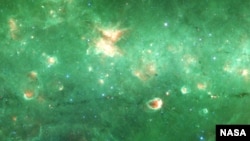Scientists have announced the discovery of a spine-like structure within the Milky Way that might help explain the dynamics of galactic formation.
The Milky Way is the spiral galaxy we live in and is one of billions of such vast pinwheel-like formations scattered throughout the universe, each containing hundreds of billions of stars.
Harvard University astronomy professor Alyssa Goodman is an expert on star formation. Not long ago, she and her colleagues at the Harvard Smithsonian Center for Astrophysics were reviewing data of a dense cosmic cloud nicknamed Nessie by the scientist who first described it.
Goodman’s team saw a new feature in the cloud, a tendril of dust and gas about 1,000 light years long, that made Nessie eight times longer than it was previously thought to be.
Since we live inside the Milky Way, it can be difficult for us to determine its exact structure. Goodman says this is the first time that scientists have seen such a delicate piece of the galactic skeleton.
“What we’ve added to this is the idea that there might be these very sharp, dense features that we can pick out of the data and that that will just add another tool to the arsenal of trying to figure out the structure of the galaxy we live in.”
Computer simulations of galaxy formation show webs of filaments within spiral disks. It is very likely that the newly discovered Milky Way feature is one of these skeletal filaments.
“If we combine this information in a statistical way, we can probably build a pretty good three-dimentional model of the galaxy,” Goodman says. The new filament is likely made from high density gas, the type that forms stars.
The discovery is an interesting demonstration of what’s called open science. Goodman and nine collaborators are writing the paper on the find, which the public can review as it evolves online at authorea.com.
“That means that as we work on the paper, which is about 90 percent done at this point, the whole world can see it. They can watch us work on it.”
Goodman presented her work at the American Astronomical Society meeting in Long Beach, California.
This article corrects an error in the original story describing the newly-calculated length of the Nessie spine structure.
The Milky Way is the spiral galaxy we live in and is one of billions of such vast pinwheel-like formations scattered throughout the universe, each containing hundreds of billions of stars.
Harvard University astronomy professor Alyssa Goodman is an expert on star formation. Not long ago, she and her colleagues at the Harvard Smithsonian Center for Astrophysics were reviewing data of a dense cosmic cloud nicknamed Nessie by the scientist who first described it.
Goodman’s team saw a new feature in the cloud, a tendril of dust and gas about 1,000 light years long, that made Nessie eight times longer than it was previously thought to be.
Since we live inside the Milky Way, it can be difficult for us to determine its exact structure. Goodman says this is the first time that scientists have seen such a delicate piece of the galactic skeleton.
“What we’ve added to this is the idea that there might be these very sharp, dense features that we can pick out of the data and that that will just add another tool to the arsenal of trying to figure out the structure of the galaxy we live in.”
Computer simulations of galaxy formation show webs of filaments within spiral disks. It is very likely that the newly discovered Milky Way feature is one of these skeletal filaments.
“If we combine this information in a statistical way, we can probably build a pretty good three-dimentional model of the galaxy,” Goodman says. The new filament is likely made from high density gas, the type that forms stars.
The discovery is an interesting demonstration of what’s called open science. Goodman and nine collaborators are writing the paper on the find, which the public can review as it evolves online at authorea.com.
“That means that as we work on the paper, which is about 90 percent done at this point, the whole world can see it. They can watch us work on it.”
Goodman presented her work at the American Astronomical Society meeting in Long Beach, California.
This article corrects an error in the original story describing the newly-calculated length of the Nessie spine structure.













